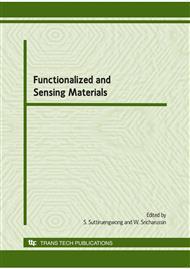p.105
p.109
p.113
p.117
p.121
p.125
p.129
p.133
p.137
Gelatin/Hydroxyapatite Scaffolds: Studies on Adhesion, Growth and Differentiation of Mesenchymal Stem Cells
Abstract:
In this work, we developed a 3-dimensional bone tissue engineering scaffold from type B gelatin and hydroxyapatite. Two types of scaffolds, pure gelatin (pI~5) (Gel) and gelatin/hydroxyapatite (30/70 wt./wt.) (Gel/HA), were prepared from concentrated solutions (5% wt./wt.) using foaming/freeze drying method. The results SEM revealed the interconnected-homogeneous pores of Gel and Gel/HA were 121 119 and 148 83m, respectively. Hydroxyapatite improved mechanical property of the gelatin scaffolds, especially at dry state. Compressive modulus of Gel and Gel/HA scaffolds were at 118±21.68 and 510±109.08 kPa, respectively. The results on in vitro cells culture showed that Gel/HA scaffolds promoted attachment of rat’s mesenchymal stem cells (MSC) to a 1.23 folds higher than the Gel scaffolds. Population doubling time (PDT) of MSC on Gel and Gel/HA scaffolds were 51.16 and 54.89 hours, respectively. In term of osteogenic differentiation, Gel/HA scaffolds tended to enhance ALP activity and calcium content of MSC better than those of the Gel scaffold. Therefore the Gel/HA scaffolds had a potential to be applied in bone tissue engineering.
Info:
Periodical:
Pages:
121-124
Citation:
Online since:
January 2010
Keywords:
Price:
Сopyright:
© 2010 Trans Tech Publications Ltd. All Rights Reserved
Share:
Citation:


